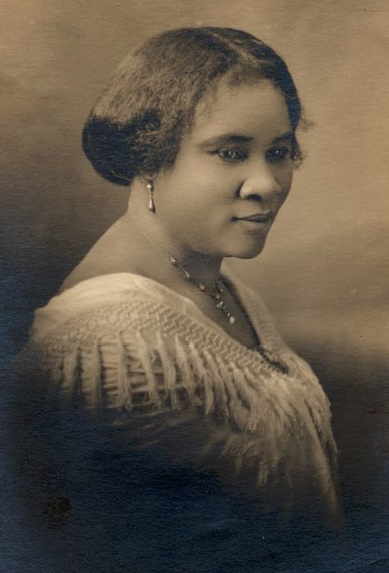Birth Date: December 23, 1867
Death Date: May 25, 1919
Location: Delta, Louisiana, USA
Monument Type: Historic/Residence

Madam C.J. Walker. [Black-and-white photoprint.] Smithsonian Institution, National Museum of American History.
Unfortunately, Sarah’s girlhood was filled with devastation. Her mother and her father died when she was young. Following her move to Mississippi, Sarah suffered abuse; it was a brother-in-law who was responsible for her pain. Sarah was only a teenager when she got married for the first time. She stated that she did this “in order to get a home of my own,” emphasizing how she envisioned this marriage as an outlet. While still a teenager, Sarah would become a mother. Tragedy would continue to strike, as Sarah’s husband would perish. These experiences ultimately shaped Sarah’s life. Additionally, while she acquired very little formal education during her childhood, Sarah’s tenacity would take her to new heights in the future.
St. Louis, Missouri, became a home to Sarah and her young child. Sarah, like many other Black women, was a washerwoman. A second marriage would fall apart. Sarah was plagued by hair loss, and she was not the only woman who suffered from that phenomenon. She would play a critical role in Black women’s beauty culture focused on hair. Utilizing her experience working for Annie Turnbo Malone, a prominent Black woman entrepreneur in the beauty industry, Sarah would venture deeper into the business world. Sarah would leave Missouri. A marital union with Charles Walker would enable Sarah to go by a new name: Madam C.J. Walker. It would not be long before that name would achieve recognition. Madam C.J. Walker went on to create her own flourishing business dedicated to Black women’s hair; she would have thousands of employees across the globe. She was heavily involved in charitable work, and she focused on social activism, enabling future generations to benefit from Madam C.J. Walker’s legacy. As she lived through the tumultuous decades following the Civil War, she emerged as a critical anti-lynching crusader. Harlem became a key place for Madam C.J. Walker to thrive. She would pass away in 1919, after having accumulated a significant net worth.
Sources
- Bundles, A’Lelia. On Her Own Ground: The Life and Times of Madam C.J. Walker. New York: Simon & Schuster, 2001.
- Michals, Debra. “Madam C. J. Walker.” National Women’s History Museum.
https://www.womenshistory.org/education-resources/biographies/madam-cj-walker
